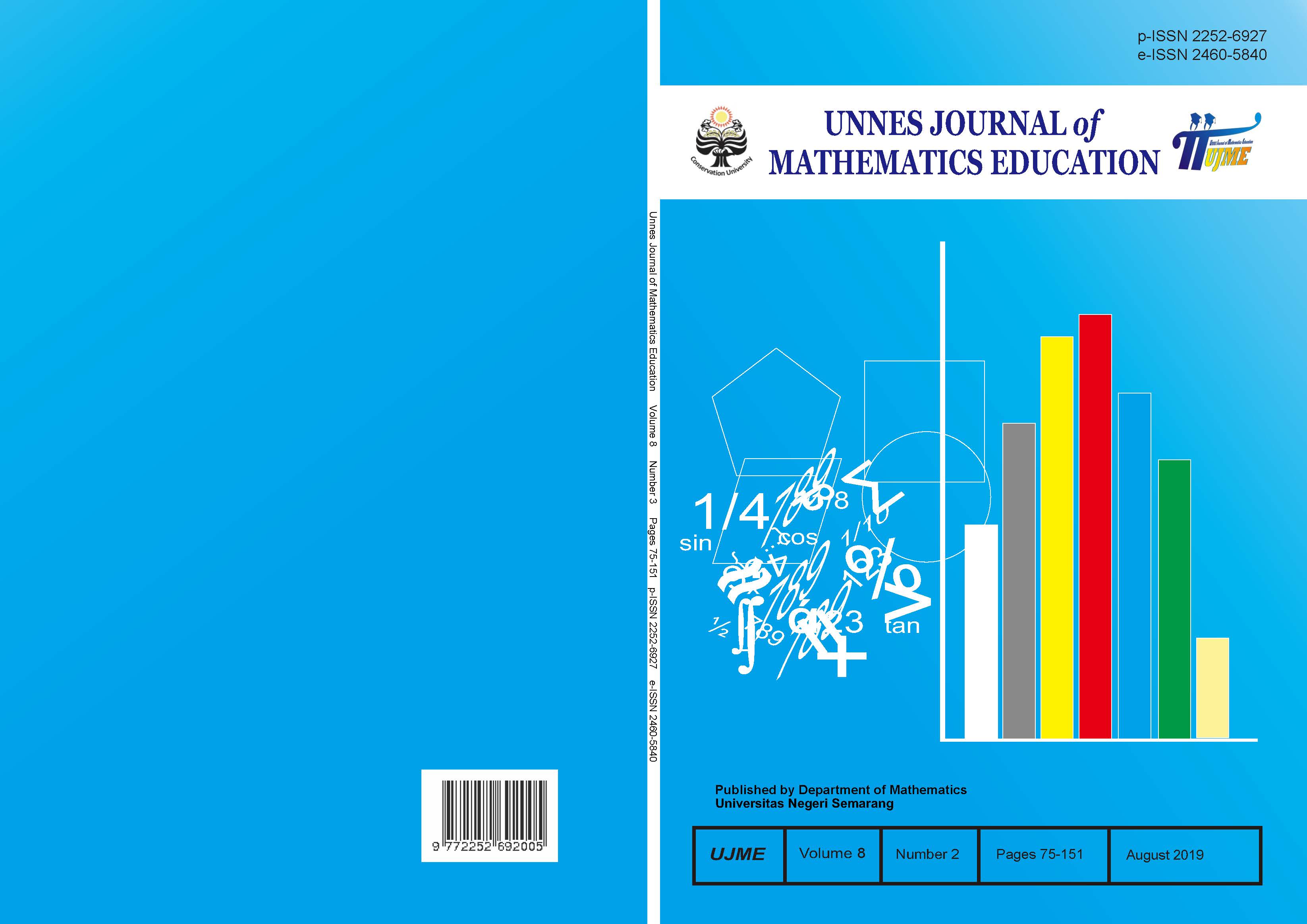The effectiveness of project based learning with creative mind-map tasks for improving mathematical connection ability and student curiosity
##plugins.themes.academic_pro.article.main##
Abstract
This study aimed to know the effectiveness of PjBL learning model with creative mind-map assignments on student’s Mathematical Connection Abilities and student’s curiosity. Population in this study was students of grade VIII SMP Negeri 1 Margorejo Pati year 2017/2018 with a true experimental design types posttest-only control design and samples were chosen randomly. Analysis of data used the proportion test and t-test. The results showed that (1) the ability of student’s mathematical connection of the subject who have gained PjBL learning model with creative mind-map assignments have achieved the classical completeness; (2) the mathematical connection abilities of students who have gained PjBL learning model with creative mind-map assignments is higher than students who have gained expository models and (3) the curiosity of students who have gained PjBL learning model with creative mind-map assignments is higher than students who have gained expository models.
##plugins.themes.academic_pro.article.details##
References
Arifin, Z. (2012). Evaluasi Pembelajaran. Bandung: Remaja Rosdakarya.
Baumgarten,Elias.(2001).Curiosity as a Moral Virtue. International Journal of Applied Philosophy.International Journal of Applied Philosophy,15(2). Retrieved from https://philpapers.org/go.pl?id=BAUCAA-2&proxyId=none&u=http%3A%2F%2Fwww-personal.umd.umich.edu%2F~elias%2Fcuriosity.pdf
Buzan, T. (2009). Buku Pintar Mind Map. Jakarta: Gramedia.
Depdikbud. (2014). Permendikbud Nomor 58 Tahun 2014 Tentang Kurikulum Sekolah Menengah Pertama. Jakarta: Depdiknas.
Hendriana, Heris, et al.(2014).Mathematical Connection Ability And Self-Confidence.International Journal of Education. 8(1).Retrieved http://ejournal.upi.edu/index.php/ije/article/view/1726/1176
Rahman, M.B.H.A. et al. (2009). Project Based Learning (PjBL) Practices at Politeknik Kota Bhar. Jurnal Ilmiah, 2(4).
Saminanto & Kartono.(2015).Analysis of Mathematical Connection Ability In Linear Equation With One Variable Based On Connectivity Theory.International Journal of Education and Research. ISSN 2411-5681
Sari, A.A. & Jarnawi, A.D. (2008). Pengaruh Pemberian Tugas Creative Mind Map setelah Pembelajaran Terhadap Kemampuan Kreativitas dan Koneksi Matematik Siswa. Prosiding Seminar Nasional Matematika dan Pendidikan Matematika. ISSN 978-979-16353-1-8
Sugandi, A., et al. (2004). Teori Pembelajaran. Semarang: UPT MKK UNNES.
Sugiyono. (2010). Statistika untuk Penelitian. Bandung: Alfabeta.
Suhana, Cucu. (2014). Konsep Strategi Pembelajaran (Edisi Revisi). Bandung: Refika Aditama.
Suherman, Erma, et al. (2003). Common Textbook Strategi Pembelajaran Matematika Kontemporer (Edisi Revisi). Bandung: JICA UPI.
Sumarmo, Utari. (2006). Pembelajaran Ketrampilan Membaca Matematika Pada Siswa Sekolah Menengah. Jurnal UPI. Retrieved from http://math.sps.upi.edu/?p=64.
Tarigan, Daitin. & Sinaga, E.M. (2015). Perbedaan Hasil Belajar Siswa dalam Pendekatan Realistik dengan Pendekatan Ekspositori pada Mata Pelajaran Matematika Kelas IV SDN 101880 Tanjung Morawa. Jurnal Kreano Unnes. ISSN 2442-4218
Wardani.(2010). Implikasi Karakteristik Matematika dalam Pencapaian Tujuan Mata Pelajaran Matematika di SMP/MTs. Yogyakarta: PPPPTK Matematika.
Wena.(2009).Strategi Pembelajaran Inovatif Kontemporer. Jakarta: Bumi aksara.
Widiyatmoko, A. & S.D. Pamelasari.(2012). Pembelajaran Berbasis Proyek untuk Mengembangkan Alat Peraga IPA dengan Memanfaatkan Bahan Bekas Pakai. Jurnal Ilmiah, 1(1) 51-56.
Widyatini, T. (2014). Penerapan Model Project Based Learning (Model Pembelajaran Berbasis Proyek) dalam Materi Pola Bilangan Kelas VII. Yogyakarta: PPPPTK Matematika.
